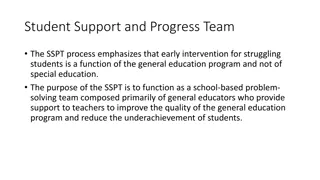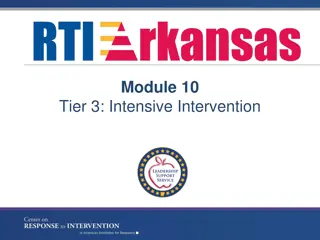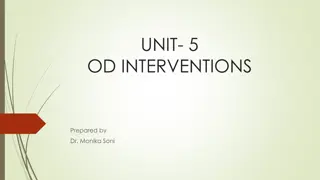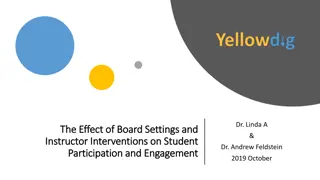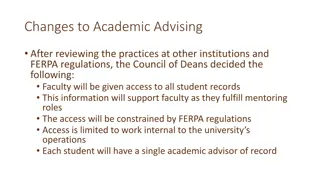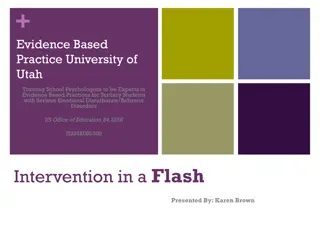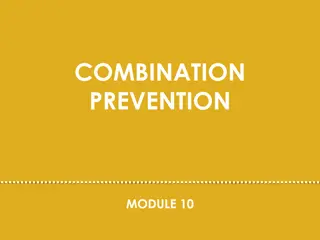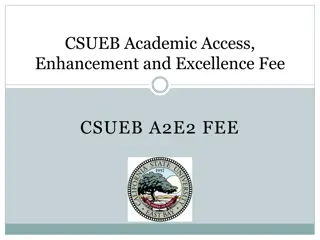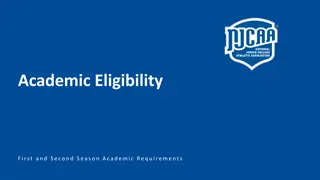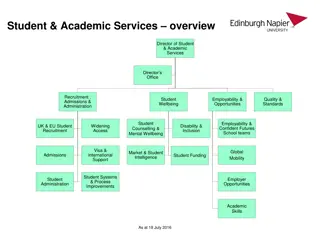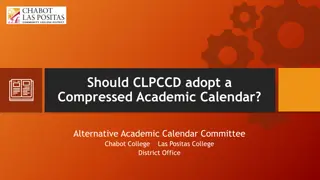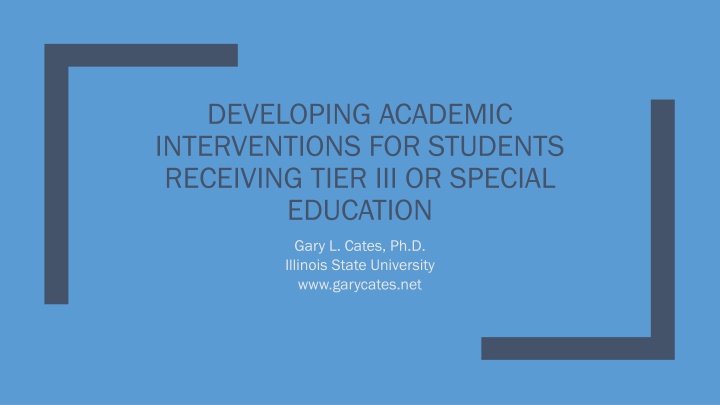
Academic Interventions for Students Receiving Tier III or Special Education
Explore challenges and current practices in individualized academic assessment and intervention for reading, written expression, and math. Learn about evaluating and implementing academic interventions for students at different tiers, along with the key questions and steps involved in the process.
Download Presentation

Please find below an Image/Link to download the presentation.
The content on the website is provided AS IS for your information and personal use only. It may not be sold, licensed, or shared on other websites without obtaining consent from the author. If you encounter any issues during the download, it is possible that the publisher has removed the file from their server.
You are allowed to download the files provided on this website for personal or commercial use, subject to the condition that they are used lawfully. All files are the property of their respective owners.
The content on the website is provided AS IS for your information and personal use only. It may not be sold, licensed, or shared on other websites without obtaining consent from the author.
E N D
Presentation Transcript
DEVELOPING ACADEMIC INTERVENTIONS FOR STUDENTS RECEIVING TIER III OR SPECIAL EDUCATION Gary L. Cates, Ph.D. Illinois State University www.garycates.net
What are your biggest challenge(s) with individualized academic assessment and intervention? Write down the answer to this question for each of the following areas: Reading Written Expression Math
Evaluate (Curriculum Based Evaluation) Tier 3 & SPED Assess (Curriculum Based Assessment) Tier 2 Measure (Curriculum Based Measurement) Tier I
What are your Current Practices? Please briefly answer the following questions: What data do you collect at the Universal Level? What Interventions do you currently have available at the Universal Level? What data do you collect at Tier 2? What Interventions do you currently have available? What data do you collect at Tier 3? What Interventions do you currently have available?
1. Screen for Academic Skill Deficit 2. Confirm Academic Skill Deficit 3. Analyze Available Data 4. Develop a Hypothesis 5. Test the Hypothesis 6. Develop a Goal 7. Evaluate & Troubleshoot Intervention 7. Develop Intervention 7. Implement Intervention
7 Big Questions Question Being asked Question Being asked Question 1. Question 1. Is there a potential skill deficiency? Question 2. Question 2. Is there a Real deficiency? Question 3. Question 3. What Pattern(s) of Responding is observed? Question 4. Question 4. Under what conditions is skill deficiency present? Question 5. Question 5. Is the above hypothesis supported when tested? Question 6. Question 6. Where do we want the student's performance to be and by when? Question 7. Question 7. Is the Intervention Effective?
Steps 3, 4, and 5 Diagnosing Specific ASD Step 1: Step 2: Screen for ASD-R Confirm ASD-R Curriculum Based Evaluation (CBE) Curriculum Based Measurement (CBM) Curriculum Based Assessment (CBA) Multiple Domain Analysis (Broad Band Assessment) Universal Screening Measures Single Domain Error Analysis
Step 1 Generic Example: Is there a potential deficit? Fall Raw Score Fall Raw Score Performance Performance 42 Percentile Rank Percentile Rank Target Student 8th Peers 107 50th Using a universal screening measure (e.g., AIMS Web Dibbles, Easy CBM, etc. )for a general skill area (i.e., reading, math, written expression, spelling)
Step 2 Generic Example: Is there a real deficit? Percentile Percentile Rank Rank Domain 1 8th Domain 2 27th Domain 3 34th Domain 4 10th Domain 5 44th Using an academic achievement test (e.g., WRMT, KEY-Math, TOWL, TOWS etc. )for a general skill area (i.e., reading, math, written expression, spelling)
Step 3 Generic Example: Analyze existing data? Percentile Percentile Rank Rank Domain 1 8th Domain 2 27th Domain 3 34th Domain 4 10th Domain 5 44th Analyze error patterns within the identified deficit areas
Step 4 Generic Example: Develop a Hypothesis Percentile Percentile Rank Rank Domain 1 8th Domain 2 27th Domain 3 34th Domain 4 10th Domain 5 44th What is contributing to the students performance? 1. Font 2. Regrouping 3. Silent e 4. Understanding Comma usage
Step 5 Generic Example: Test Hypothesis Percentile Percentile Rank Rank Domain 1 8th Domain 2 27th Domain 3 34th Domain 4 10th Domain 5 44th Construct a test for the hypothesis within the domains Probes with different font, Probes that that require regrouping, Flash cards of Words with and without Silent E, probes that require understanding of commas
Step 6 Generic Example: Develop a Goal Fall Raw Score Fall Raw Score Performance Performance 42 Percentile Rank Percentile Rank Target Student 8th Peers 107 50th Returning to USM: Set a goal that includes level of performance, conditions, and timeline. Given a probe, Gary will be able to complete 10 items with 90% accuracy within 15 Given a probe, Gary will be able to complete 10 items with 90% accuracy within 15 minutes by October 15 minutes by October 15th th. .
Step 7 Generic Example: Intervention Development, Implementation, and Evaluation Matching Domain/Skill with the intervention? Intervention Fidelity/Integrity checked? Data graphed? Goal set: Level of performance, date, conditions?
UNDERSTANDING LEARNING THROUGH THE INSTRUCTIONAL HIERARCHY Stages of Learning Require Different Approaches
Adaptation Problem Solving Simulations Generalization Discrimination Training Differentiation Training Fluency Drill Reinforcement Acquisition Demonstration Modeling Prompting Cuing
No Use Procedures that include Demonstration, Modeling and/or Prompting No Accuracy at 90% or higher? Drill and/or Provide Incentive No Yes Provide Practice in new situations/environments Fluency at desired level? No Yes provide simulations and encourage problem-solving with the skill Skill happening in New environments/situations? Yes Skill being used in conjunction with other skills? Yes Congratulations!
APPLICATION TO READING
Big 5 Areas of Reading Phonemic Awareness Alphabetic principle Fluency Vocabulary Comprehension
Early Literacy Intervention Principles Exposure of letters, letter sounds etc. Essentially building Alphabetic Principle demonstration and modeling prompting and cuing Repeated Practice of acquired skills learned through exposure Discrimination Training/Differentiation FUN! Must train the exceptions!
Early Literacy Interventions Flash Card Drills with incentives Letter/Sound Bingo Around the world Chess Clock competitions Color by Letter
Reading Accuracy Percent of words read correctly Dependent upon sub skills: Sight words Phonics Context Affected by word difficulty
Reading Accuracy Interventions Word Supply Demonstration (Acquisition) Sentence Repeat Repeated Practice (Generalization) Error Drill Repeated Practice (Fluency)
Reading Fluency Accuracy Rate: Number of correct words read per minute Affected by Accuracy
Fluency Building Interventions Repeated Reading Repeated Practice Listening Passage Preview Modeling/Demonstration Paired Reading Modeling with support fading
Reading Comprehension Reading Difficulty Background Knowledge Motivation (i.e. level of reinforcement) Interest in the topic Passage Length
Measuring Reading Comprehension Multiple Choice True/False Fill in the blank Essay CLOZE MAZE Retell Question Rate/Frequency
Reading Comprehension Interventions TELLS POSSE Vocabulary Preview Question Preview Click or Clunk Question Interspersal
TYING IT ALL TOGETHER Reading Example
Academic Intervention Consultation Service (AICS) Process Referral resulting in 8 week admission 2 times per week for 50 minutes hour parent interview hour initial assessment time AIMSWeb Maze, ORF, TELS Woodcock Reading Mastery Test 3 Full Reading Passages (AimsWeb or Jamestown Series) Accuracy Protocol, Fluency Protocol, Comprehension Protocol Alternative: Early Literacy Skill Development Additional: Exceptions training
Step 1 Reading Example: Is there a potential deficit? Percent Percent Accuracy Accuracy 100% MAZE MAZE MAZE MAZE Correct Correct Percentile Rank Percentile Rank Trial 1 Trial 1 17 57 62 Trial 2 Trial 2 17 57 62 100% Trial 3 Trial 3 14 39 44 100% Words Read Correctly (WWC) 81 R R- -CBM CBM Percentile Rank Percent Accuracy Trial 1 Trial 1 22 23 96% Trial 2 Trial 2 78 20 21 97% Trial 3 Trial 3 78 20 21 98%
Step 2 WRMT: Is there a real deficit? Standard Standard Score Score 105 Percentile Percentile Rank Rank 63 Confidence Confidence Interval Interval 100 110 Composite/Subtest Composite/Subtest Description Description Total Reading Total Reading Listening Listening Comprehension Comprehension Oral Reading Fluency Oral Reading Fluency Basic Skills Basic Skills Word Identification Word Identification Word Attack Word Attack Reading Comprehension Reading Comprehension Word Comprehension Word Comprehension Passage Passage Comprehension Comprehension Average 117 87 106 128 Above Average 84 103 97 109 118 116 14 58 42 73 88 86 75 93 96 110 88 106 100 118 111 125 109 123 Below Average Average Average Average Above Average Above Average 117 87 106 128 Above Average
Step 3 Reading Example: Analyze existing data 1. Omissions, Pauses, Insertions, Substitutions (Circle all that apply) 2. Does not know letter sounds or letters _______________________ 3. Long vowel short vowel discrimination 4. Does not blend diagraphs 5. Does not demonstrate basic rules 6. Rule exception violations 7. Self Corrections: ____Percent of Self Corrections that: Change meaning ______ Do not Change meaning _____ 8. Other (Describe):
Step 3 Reading Example: Analyze existing data 1. Omissions, Pauses, Insertions, Substitutions (Circle all that apply) 2. Does not know letter sounds or letters ___None___________ 3. Long vowel short vowel discrimination E U A 4. Does not blend diagraphs None 5. Does not demonstrate basic rules N/A 6. Rule exception violations __gh, ph__ 7. Self Corrections: 20 Percent of Errors are Self Corrections that: Change meaning ___5% Do not Change meaning __95% 8. Other (Describe):
Step 4 Reading: Develop a Hypothesis When reading orally, Gary often pauses or substitutes words and self- corrects his reading errors. 5% of the time these errors change meaning of the reading. Many of his substitutions are related to long and short vowel sounds. Hypothesis: Gary s reading fluency is low because: The rate of pauses or substituting that result in self correction is too high. His substitutions are due to insufficient instruction in short and long vowel sounds If we drop the instructional reading level this rate should improve.
Step 5 Reading Example: Test Hypothesis 1. Omissions, Pauses, Insertions, Substitutions (Circle all that apply) 2. Does not know letter sounds or letters ___N/A___________ 3. Long vowel short vowel discrimination N/A 4. Does not blend diagraphs N/A 5. Does not demonstrate basic rules N/A 6. Rule exception violations __N/A 7. Self Corrections: 1 Percent of Self Corrections that: Change meaning ___0 Do not Change meaning __100% 8. Other (Describe):
Step 5: Testing Hypothesis by decreasing Grade Level Probe Probe Score Score Words Read Correctly (WWC) Percent Accuracy R R- -CBM CBM Trial 1 Trial 1 102 96% Trial 2 Trial 2 107 97% Trial 3 Trial 3 105 98%
Step 6 Reading Example: Develop a Goal Given a grade level reading probe, Gary will be able to read at or Given a grade level reading probe, Gary will be able to read at or above the 25 above the 25th th percentile with 95% accuracy by the next bench percentile with 95% accuracy by the next bench marking period. marking period. Given a grade level reading probe, Gary s accuracy levels in Given a grade level reading probe, Gary s accuracy levels in substations and pauses will increase to 95% by the next bench substations and pauses will increase to 95% by the next bench marking period. marking period.
Step 7 Reading Example: Intervention Development The intervention MUST Match the Domain/Skill Deficiency Vocabulary Review Acquisition of words: Demonstration Error Drill Acquisition of words: Demonstration Direct Instruction in A E and U vowel sounds in isolation Acquisition of Skills: Demonstration Direct Instruction in gh and ph in isolation Discrimination Training
Brief Experimental Analysis of Academic Responding: Fluency Oral Reading Fluency Interventions Oral Reading Fluency Interventions 128 130 122 125 Words Read Per Minute Words Read Per Minute 120 115 111 109106 110 103 105 Listening Passage Preview 97 97 100 92 96 95 91 91 98 89 Repeated Reading Trial 2 90 85 84 83 91 85 80 T1 T2 T3 T4 T5 T6 T7 T8 T9 T10 T11
Experimental Analysis of Academic Responding: Accuracy Error Drill v. Vocabulary Review Error Drill v. Vocabulary Review 100% 100% 90% 90% 100% 90% 100% 70% 80% 90% 70% 50% 50% 60% Error Drill Vocabulary Review 50% 30% 40% 30% 20% 0% 0% 10% 0% BL TI T2 T3 T4 T5 BL = Basline T= Trial BL = Basline T= Trial
Direct Instruction long E Long Long \ \e e\ \ "ey": Mastered "ey": Mastered 100% 100% 100% 100% 90% Percentage Correct Percentage Correct 80% 60% 40% 20% 0% BL T1 T2 T3 BL = Baseline T = Trial BL = Baseline T = Trial
Direct Instruction silent e Long Long \ \u u\ \ "silent e": Mastered "silent e": Mastered 100% Percentage Correct Percentage Correct 100% 100% 95% 80% 85% 75% 60% 40% 20% 0% BL T1 BL = Baseline T = Trial BL = Baseline T = Trial T2 T3 T4
Direct Instruction on Long A Long Long \ \a a\ \ "ay": Mastered "ay": Mastered 100% Percentage Correct Percentage Correct 100% 100% 95% 80% 90% 80% 60% 40% 20% 0% BL T1 T2 T3 T4 BL = Baseline T = Trial BL = Baseline T = Trial
Direct Instruction: ph "ph": Mastered "ph": Mastered 100% Percentage Correct Percentage Correct 100% 100% 95% 80% 60% 65% 40% 20% 0% BL T1 T2 T3 BL = Baseline T = Trial BL = Baseline T = Trial
Direct Instruction: gh "gh" "gh" 100% Percentage Correct Percentage Correct 100% 95% 95% 80% 75% 60% 40% 20% 0% BL T1 T2 T3 BL = Baseline T = Trial BL = Baseline T = Trial
Reading Comprehension: What about it? Jamestown Passages: Comprehension Score Jamestown Passages: Comprehension Score 10 10 10 10 9 10 8 9 8 7 6 5 4 3 2 1 0 T1 T2 T3 T4 T5 T6 T = Trial T = Trial
What Makes up a Good Math Curriculum? Numbers & Operations with Procedural Fluency Algebra Geometry Measurement Data Analysis Statistics, & Probability National Council of Teachers of Mathematics2
What Makes up Good Math Instructional Practices Institute of Educational Sciences: National Center for Education Evaluation and Regional Assistance http://www.rti4success.org/images/stories/tieredInstruction/rti_math_pg_042109. pdf 3 8 Recommendations
Other TIER II Math Interventions Program Fast Math Mastering Math Facts Math Facts in a Flash Peer Assisted Learning Strategies (PALS) First Grade Small Group Tutoring Connecting Math Concepts Corrective Mathematics Knowing Mathematics Navigator Voyager Mathematics (Vmath) iSucceed Math Accelerated Math Hot Math Pirate Math Go Solve Word Problems Math Steps Number Worlds GRADE LEVELS 2 and up 2 and up 1-6 K-6 1 K-8 1-6 4-6 1-8 3-8 3-8 1-12 K-3 2-5 3-8 K-7 PreK-8

